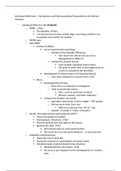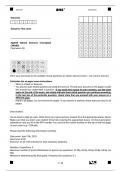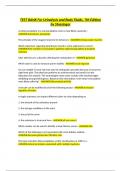Video
• Until early 2000s, phones were sustaining technologies
• iPhone was a disruptive technology
Inertia: resistance to change
• 3 reasons for inertia in established organizations:
o Strategic frame rigidity
o Routine rigidity: condition that organizational processes become established
over time and become harder to change
o Resource rigidity: company`s inability to invest in resources that become
important as a result of new developments in its industry
Sull (1999): Why Good Companies Go Bad
One of the most common business phenomena is also one of the most perplexing: when
successful companies face big changes in their environment, they often fail to respond
effectively.
• The problem is not an inability to take action but an inability to take appropriate action.
• A reason for that is active inertia: an organization’s tendency to follow established
patterns of behavior—even in response to dramatic environmental shifts. Stuck in the
modes of thinking and working that brought success in the past, market leaders simply
accelerate all their tried-and-true activities. In trying to dig themselves out of a hole,
they just deepen it.
The dynamic of failure
• Strategic frames become blinders
, o But while frames help managers to see, they can also blind them. By focusing
managers’ attention repeatedly on certain things, frames can seduce them into
believing that these are the only things that matter.
o As a strategic frame grows more rigid, managers often force surprising
information into existing schema or ignore it altogether.
• Processes harden into routines
o People follow the processes not because they’re effective or efficient but
because they’re well known and comfortable. They are simply “the way things
are done.” Once a process becomes a routine, it prevents employees from
considering new ways of working. Alternative processes never get considered,
much less tried. Active inertia sets in.
• Relationships become shackles
o When conditions shift, however, companies often find that their relationships
have turned into shackles, limiting their flexibility and leading them into active
inertia. The need to maintain existing relationships with customers can hinder
companies in developing new products or focusing on new markets. Managers
can also find themselves constrained by their relationships with employees.
• Values harden into dogmas
o As companies mature, their values often harden into rigid rules and regulations
that have legitimacy simply because they’re enshrined in precedent.
Successful companies can avoid—or at least overcome—active inertia. First, though, they have
to break free from the assumption that their worst enemy is paralysis. They need to realize that
action alone solves nothing. In fact, it often makes matters worse. Instead of rushing to ask,
“What should we do?” managers should pause to ask, “What hinders us?” That question
focuses attention on the proper things: the strategic frames, processes, relationships, and values
that can subvert action by channeling it in the wrong direction.
Active inertia exists because the pull of the past is so strong. Trying to break that pull through
a radical act of organizational revolution leaves people disoriented and disenfranchised, cut off
from the past but unprepared to enter the future. It’s better for managers to respect the
company’s heritage. They should build on the foundations of the past even as they teach
employees that old strategic frames, processes, relationships, and values need to be recast to
meet new challenges.
Kapoor, Klueter (2015): Decoding the Adaptability–Rigidity Puzzle
The emergence of radical technologies presents a significant challenge to incumbent firms.
• We introduce two contingencies to explain when incumbents’ research investments in
radical technologies translate into product development and when these upstream
investments may get voided by organizational inertia downstream.
We shed light on this puzzle by explaining when incumbents’ well-intended investments in a
radical technological regime are likely to facilitate adaptation, and when these investments may
get voided by the forces of organizational inertia.
2 contingencies that affect the likelihood that a firm’s research investment in a radical
technological regime will lead to product development:
, • First, radical technologies can differ in how they conform to incumbents’ existing
business models, impacting the extent to which the movement of research outputs
toward development will be subject to inertial pressures.
• Second, incumbents can invest in a radical technology through a variety of modes
(internal research, external research contracts, alliances, acquisitions). These modes
represent unique combinations of who does research and who is involved in the decision
for subsequent development, and, hence, differ in the extent to which they are shielded
from inertial pressures. This difference helps explain why incumbents, despite
responding to radical technologies, may still be unable to adapt, as well as what types
of investments will be more effective in helping firms navigate technological change.
o Investments in in-house (internal research) and contract research will less likely
lead to development when the technological regime is disruptive than when it
is sustaining.
o For disruptive technological regimes, investments in alliances and acquisitions
will more likely lead to development than will investments in contract and in-
house research.
• The locus of incumbents’ inertia is not necessarily at the initial stage of research but
rather at the later stage of development.
• Research alliances and acquisitions may help firms overcome that inertia.
Sustaining technological regime: new technological developments that allow companies to
create customer value with their existing business models.
The emergence of digital camera technology is NOT a sustaining technological regime for
photography companies like Polaroid.
Polaroid’s steady decline illustrates how once-vibrant values can ossify. Founded by inventor
Edwin Land, Polaroid rose to prominence by pioneering a series of exciting technologies like
instant photography, and its employees prided themselves on the company’s R&D leadership.
But over time, Polaroid’s devotion to excellent research turned into a disdain for other business
activities. Marketing and finance, in particular, were considered relatively unimportant so long
as the company had cutting-edge technology. Valuing technological breakthroughs above all
else, Polaroid’s managers continued to invest heavily in research without adequately
considering how customers would respond. Not surprisingly, sales stagnated. Today the
company is worth only one-third of what a bidder offered in an acquisition attempt in 1989.
CASE 1: Capabilities, Cognition, and Inertia: Evidence from Digital Imaging (Polaroid,
2000)
• Established firms often have difficulty adapting to radical technological change.
• Response of Polaroid Corporation to the ongoing shift from analog to digital imaging.
• The Polaroid story clearly illustrates the importance of managerial cognitive
representations in directing search processes in a new learning environment, the
evolutionary trajectory of organizational capabilities, and ultimately processes of
organizational adaptation.
• Despite early investments and leading-edge technical capability in areas related to
digital imaging, the firm has so far not performed well in the digital imaging market.
, • We find that by restricting and directing search activities related to technology
development, managerial cognition influences the development of new capability.
o For instance, given Polaroid senior management’s belief in pursuing large scale
“impossible” technological advances, the firm made significant investments in
developing technical capability related to digital imaging.
o At the same time, their belief in a razor/blade business model delayed
commercialization of a stand-alone digital camera product.
• Understanding processes of organizational change requires examining not only the
central inertial forces associated with developing new capabilities, but also the impact
that cognition has on such processes.
• Polaroid’s capabilities centered around its dominant position in instant photography.
• Manufacturing was another of Polaroid’s strengths.
• Polaroid was clearly a technology-driven, not market-driven company. Land did not
believe in performing market research as an input to product development; Polaroid’s
technology and products would create a market.
Beliefs:
• Consistent with this philosophy, Polaroid management firmly believed that success
came through long-term, large scale research projects.
• Another firmly held belief of management was that customers valued a physical instant
print. Thus, products such as video camcorders were not considered competition.
• Finally, there was a strong belief in the razor/blade business model.
o The firm dropped prices on cameras in order to stimulate adoption and
subsequent demand for film. Film prices and thus margins were then increased.
o This strategy was extremely successful, and over time a fundamental,
commonly held belief developed: Polaroid could not make money on hardware,
only software (i.e., film).
McCune began by committing substantial investment dollars to digital imaging technologies.
By 1989, 42% of R&D dollars were devoted to exploring a broad range of digital imaging
technologies.
While the beliefs of senior management clearly influenced search activities that did take place,
they also had a direct influence on activities that did not take place. In particular, there were
three important areas of capability that Polaroid did not invest in: low-cost electronics
manufacturing capability, rapid product development capability, and new marketing and sales
capability.
• In order to compete successfully in the hardware arena using a business model different
from the traditional razor/blade approach, Polaroid would have to have developed low-
cost electronics manufacturing capability and rapid product development capability –
two areas in which Polaroid was particularly weak.
• “…Polaroid didn’t have a sense of the distinction between research and product
development. It was all mixed up. Many people were totally oblivious to what it means
to get a product really developed and make it ready for the market place.” Although it
is unclear whether Polaroid could have been successful at developing either of these
capabilities, senior management’s belief in the razor/blade business model and their
resistance to supporting activities that were not fully consistent with this view precluded
any investment in them.











